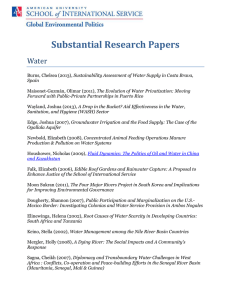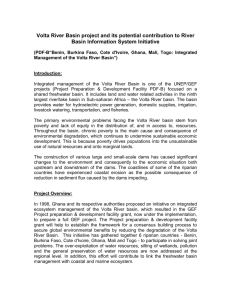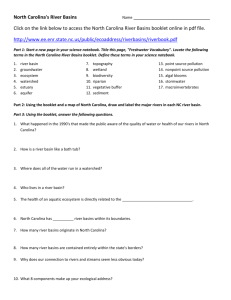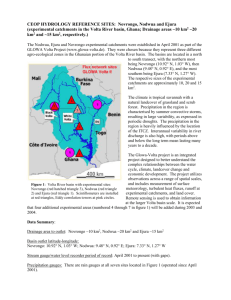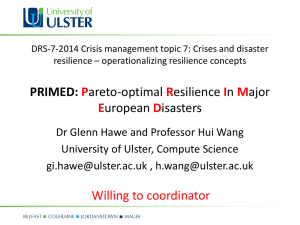030713 1300-1320 WB Intro - ClimDev
advertisement
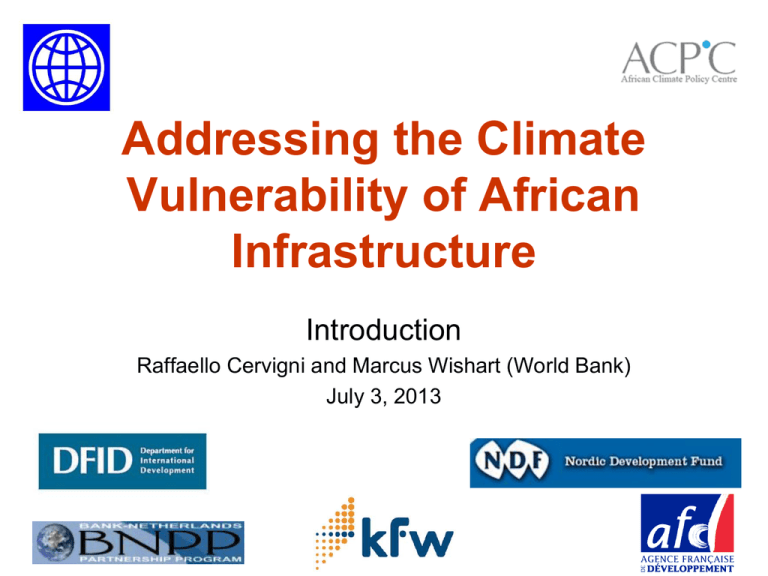
Addressing the Climate Vulnerability of African Infrastructure Introduction Raffaello Cervigni and Marcus Wishart (World Bank) July 3, 2013 Existing Body of Knowledge Current Context & Value Added ? • Africa wide comparative assessment » Quantify CC impacts on performance of network infrastructure; » Identify, evaluate and cost robust adaptation approaches for planning, evaluating, and designing specific infrastructure investments in the face of climate uncertainty; » Formulate actionable recommendations for policy makers on how to enhance the climate resilience of infrastructure development and mobilize the required resources. • Orange-Senqu accounts for over 10% of Africa’s GDP • 3rd most economically important basin in Africa • Regional WBG Portfolio of activities Lesotho Water Sector Improvement Project Lesotho Highlands – Botswana Water Transfer Study Lesotho CC Scenario Analysis to Strengthen Economic Planning (GFDRR) Starting points: Africa Infrastructure Country Diagnostic (AICD)… • Comprehensive overview of current infrastructure status, policy, institutional and financial challenges • Concludes that Africa needs to spend US$93bn pa to catch-up on infrastructure with rest of developing world • Estimates made under a “no climate change” presumption Key finding: $93 billion financing needs, $31 billion gap to fill Resource needed to upgrade Africa Infrastructure (US$ billion/ year) 45 40 35 30 25 20 15 10 5 0 Electricity Water supply and sanitation Spending 5 Transport ICT Efficiency gap Funding gap Source: Africa Infrastructure Country Diagnostic (AICD) Irrigation ..and Program for Infrastructure development in Africa (PIDA) Sector Modern highways Modern railways Cost of Priority Action Plan $68 billion) billion 2012-2020 (US$ Transport 37% Port capacity Hydroelectric power generation Interconnecting power lines New water storage capacity Energy 59% TWR 3% ICT 1% 6 Target by 2040 37,300 km 30,200 km 1.3 billion tons 54,150 MW 16,500 km 20,101 hm3 WHAT HAPPENS WITH CLIMATE CHANGE? 7 Main implications 1. Can no longer plan and design infrastructures as we did in the past: risk of “regrets” 2. Need new approaches to deal with the changing, but uncertain, climate of the future 3. Might need to incur higher costs 8 Why a new study? 1. Few existing national, sub-regional and regional infrastructure development plans address climate change implications 2. Existing studies on climate change tend to: – Focus on impact – Address one sector at a time – Provide limited project-level insights on adaptation responses 3. Climate science is evolving 9 Climate science: consensus on change, uncertainty on direction/ magnitude Return to main slide show Why a regional approach? 1. Economies of scale in knowledge generation 2. Regional/ sub regional infrastructure integration 3. Informing dialogue on development/ climate finance (e.g. IDA, Climate Negotiations) 11 A partnership to support investments in Africa’s infrastructure under an uncertain future climate Partners Donors DFID Nordic Dev Fund Germany (KfW) France (AFD) BNPP TFESSD 12 Implementation World Bank; Africa Climate Policy Center (UNECA) AU/NEPAD/AfDB RECs RBOs Power Pools Others? Overall objective “Strengthen the analytical base for investments in Africa’s infrastructure under a future uncertain climate, to facilitate and support climate resilient infrastructure development.” Specific Objectives 1. Evaluate (in physical and cost terms) the impacts of climate change on a subset of infrastructures (roads, hydro‐power and irrigation) 2. Develop and test a framework for investment decision-making that can be ‘robust’ under a wide range of climate outcomes; 3. Formulate actionable recommendations for decision makers to enhance climate resilience of infrastructure development. Scope: Seven Major River Basins… Senegal Nile Niger Volta Congo Zambezi Orange … four Power Pools.. ..and five types of infrastructures • • • • • Municipal water supply Irrigation Hydro-power Other power sources Roads Two tracks of analysis • Track 1: coarser scale (basins and power pools) – Emphasis on planning, trade-offs among policy objectives • Track 2: specific investments scale – Emphasis on project design options Overview of approach 1. Define a set of development targets – – PIDA Other plans 2. Define a reference case (no climate change) – Use historical climate 3. Evaluate deviations (+/-) from target under a wide range of climate scenarios (including IPCC AR5) 4. Analyze (including costs) options to minimize risk of not achieving targets through “Robust Decision-making” (RDM): – – At basin/ power pool scale (track 1) At investment level scale (track 2) Value added: – – Consistent regional approach to impact analysis Innovative treatment of uncertainty in adaptation analysis Progress to date • Stock taking of relevant initiatives/ data (including baseline plans) • Definition of a conceptual and modeling framework • First set of results: Volta Basin, Southern Africa Power Pool Track 2: provisional list of case studies Countries Case study Kenya Mombasa Water Supply DRC Inga 3 Malawi Fufu hydropower Ghana Pwalugu multi-purpose dam Burkina Faso Numba multi-purpose dam Guinea/ Sierra Leone Boureya dam Senegal/ Mali Senegal River Navigability Project Next steps • 2012: scoping of work, stock-taking, fund-raising • 2013, July: start road component ; interim report • August – Dec – – – – Workshops: Volta, follow-up Orange (proposed) Track 1 analysis in other river basins Energy analysis in other power pools Track 2 case studies • 2014: Jan-March: report preparation • May: review • Summer: dissemination Workshop Objectives PREMISE: Orange-Senqu: advanced stage of planning/ modeling, thus excellent sounding board for proposed approach OBJECTIVES: • Present, and elicit feedback on: – Modeling tools (hydrology, power) proposed for analysis – Decision analysis framework proposed to evaluate potential climate impacts on investment decisions • Discuss options for follow-up collaboration, including: – Options for project-level (track 2) analysis of climate resilience – Workshop after the summer to discuss advanced Orange/Senqu specific results Workshop Agenda • July 3rd afternoon – Presentations from country delegations – Overview of framework of study – The modeling tools (hydrology, power) • July 4th, morning – Participatory scoping of Orange-Senqu analysis – Illustrative applications (focus on the Volta basin) • July 4th, afternoon – Project level analysis of climate resilience – Next steps
